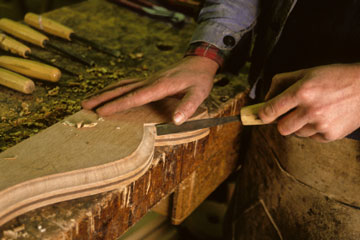*Positioning
Is there still a difference between craftsmanship and industry?

The term “industry” originates from the Latin word “industria,” meaning diligence or activity. When we think of industry, images of tall smoking chimneys towering over buildings with flat roofs often come to mind. However, when we think of craftsmanship, we envision entirely different scenes. For instance, we might imagine a furniture maker in a quaint Italian-like backstreet, working with his hammer, chisel, and sandpaper to create a one-of-a-kind piece of furniture. But is the difference between industry and craftsmanship really that significant?

In many cases, our work with industrial companies has shown that the difference is not as significant as commonly perceived. Of course, a large part of the global industry is still focused on producing goods as cheaply as possible, but this is gradually disappearing from high-wage countries like the Netherlands. The competition from countries like China is fierce, and Dutch companies competing on price only have one option left: to further optimize the process. However, competing on price, the so-called “race to the bottom,” only leads to losers in the long term.
That’s why we prefer to use the term “artisanal industry” when we encounter such companies in practice. But what does this term mean to us? We simply understand artisanal industry to be industrial companies where quality, not quantity, truly predominates. (And they must do more than just claim it.) These companies are capable not only of accepting and executing an order but also of thinking along and constantly seeking new possibilities to improve the final product. In turn, such possibilities—usually as part of something larger—lead to global-level innovations. The “impossible is nothing” mentality prevails and makes the individual price of the product much less relevant.
A striking example:
Some time ago, Felix Baumgartner jumped from 39 kilometers high with his parachute from a hot air balloon towards the Earth. It was a breathtaking achievement, and the attempt was followed live by millions of people. But consider what preceded it. The hot air balloon alone is an impressive piece of engineering! This balloon—the largest ever!—is made of a special type of plastic and is only 0.02 millimeters thick. That’s ten times thinner than a sandwich bag! Felix Baumgartner had to rely on the unique properties of the material because without it, the whole project probably wouldn’t have been possible. Assuming this material was developed not in a backstreet but in a high-tech industrial company—perhaps with fewer chimneys but definitely industrial—isn’t it an artisanal masterpiece? We think so.
Many of our industrial clients are constantly innovating and, for example, as producers of a semi-finished product, create new possibilities that lead to major innovations. These are innovations in the medical field, the energy sector, or aerospace! We see companies capable of this as the ultimate craftsmen of the 21st century!
The future of artisanal industry
Artisanal industry is fascinating because it challenges the traditional divide between the handmade and mass-produced, demonstrating that high-quality, innovative products can be produced at an industrial scale. These companies combine the best of both worlds: the efficiency and scalability of industrial production with the creativity, customization, and quality typically associated with artisanal work. This convergence allows for the creation of unique products that meet specific needs while also pushing the boundaries of what is technically and creatively possible.
In the context of high-wage countries, where competing on price is not sustainable due to global competition, artisanal industry represents a viable path forward. It allows companies to differentiate themselves in the global marketplace by offering products that are not just commodities but are distinguished by their quality, innovation, and the story behind their creation. This approach aligns with contemporary consumer values that increasingly prioritize sustainability, authenticity, and the impact of products on society and the environment.
In summary, artisanal industry is intriguing because it embodies a modern renaissance of craftsmanship within the industrial context, promising a future where products are valued not just for their functionality but also for their craftsmanship and contribution to innovation and sustainability.